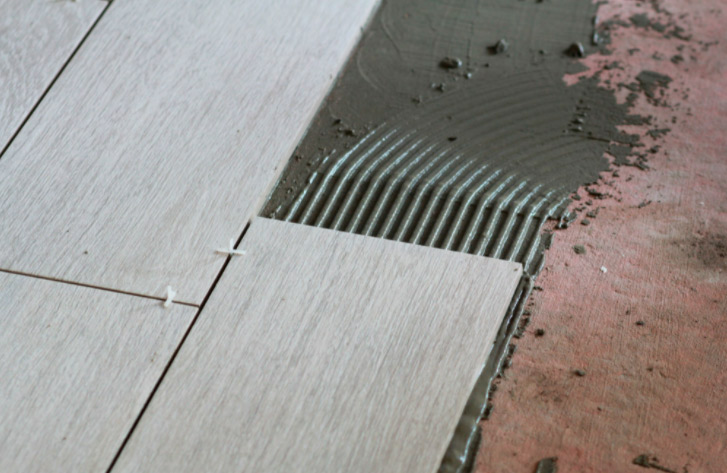Linoleum floors are durable and easy to clean, but tile offers your home an extra touch of sophistication and modern style. If you currently have linoleum floors, can you lay tile over linoleum without having to remove it first?
Read on to learn more about the process of installing tile over linoleum floors, and if it can be done at all.

Can You Lay Tile Over Linoleum?
If you want to install beautiful tile in your home, you’ll need to have a level, sturdy subfloor or base to start from. When you ask, can you lay tile over linoleum, the answer is really a maybe…
There are a few things you’ll need to consider before you head out to pick out your beautiful new tile and start the installation process. If your floors consist of sheet linoleum that was manufactured around or before the 1980s, there is a good possibility that it contains asbestos. This cancer-causing material will need to be removed by professionals before you can install new floors.
Another factor to consider is the condition of your linoleum. What is linoleum, anyway? This flooring is a combination of solidified linseed oil, sawdust, pine resin, cork dust, and other fillers attached to a canvas backing.
If your linoleum floors are starting to become loose, uneven, or warped, installing tile over them is NOT recommended. Tile needs a smooth, level base in order for it to stay securely in place. Damaged linoleum floors should be removed so that your new tile can go onto an even surface.
You should also check to see how secure the linoleum is attached to the subfloor. If it’s not securely in place, it will make the tiling job that much more difficult.
Finally, determine whether your linoleum floor is cushioned. As time goes on, this cushioning can be flatted which will allow dents and markings to show through. This means that your subfloor won’t provide a stable foundation for the tile. At this point, the cushioning will likely need to come out with the floors.
Laying Tile Over Linoleum
If you’ve decided that you’re going to lay new tile over linoleum, there are some key things to keep in mind. When linoleum floors are installed a bit of glue is applied to the edges and the center, while areas in-between don’t, and can cause the linoleum to “come up” from the subfloor. To tighten the floors, fasten them with a one-inch, rust-proof screw or nail every six inches.
Tile needs a thin-set to adhere to the subfloor, so read the manufacturer’s recommendations carefully to ensure you choose the right type.
Before applying the mortar or thin-set, clean the linoleum and let it dry completely to ensure a secure bond. Once you confirm that your linoleum is free of asbestos, irritate or scratch the surface using sandpaper, then clean it thoroughly before applying the thin-set. This tip is to help the bond between the tile and linoleum to strengthen. There are primers on the market made specifically for adhering tile to linoleum nowadays. Might want to consider investing in such a product.
A friendly reminder now is to remove all baseboards or stripping before you tile the floors. Put the baseboards aside until after your tiling job is complete. If you prefer, you can also purchase new baseboards to match the new look.

Consider Using Backer Board
A quality tile installation requires something called backer board, which is sheets of material that are similar to drywall. Nowadays you can find them made of a variety of materials, like cement or gypsum. They help provide a moisture-proof barrier between the tile and the subfloor.
When you look at how to lay tile over your linoleum, consider adding a cement backer board. This option tends to last the longest compared to some other alternatives. When you install the backer board, it adds another layer to your floors. It provides you with a smooth, even surface that you can use to add the tile over the linoleum.
Make sure that the backer board is level and plumb with the wall. To cut the backer board, simply score & snap it using a sharp tool to ensure an even cut. Once all the backer board is secured over the linoleum, then it’s safe to start applying the thin-set.
One key thing to keep in mind will be the new height of your floors. With or without the backer board, installing tiles like stone or ceramic will add more height to the finished floor. Sometimes as much as a full inch or more. If your floors become higher, you will need to cut away some of the trim around doorways and cabinets. An extra step to make the tiles fit. Something to think about before you decide whether or not installing new tile over linoleum is the right option.
Another alternative to installing a backer board is to choose floating tiles. These modern types of tiles can also be installed right over linoleum. They’re easier to remove if you ever want to change your floors in the future.
Refresh Your Floors with New Tile
As you ask yourself, can you lay tile over linoleum, the answer is actually a maybe. Depending on the age of your linoleum, its condition, and other factors, it’s possible that you can install new tiles over your existing floors. When in doubt, talk to the professionals at Rubi Tools USA.
To find out more about our products and how we can help you with all of your tiling needs, explore the rest of our website, download our full catalog today.



Post a comment